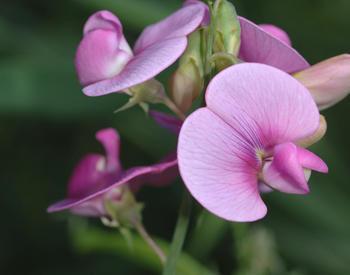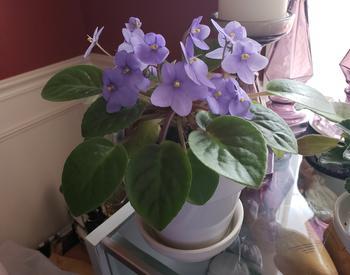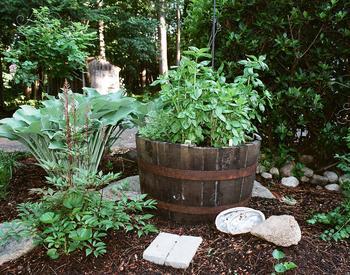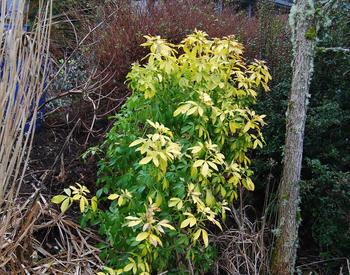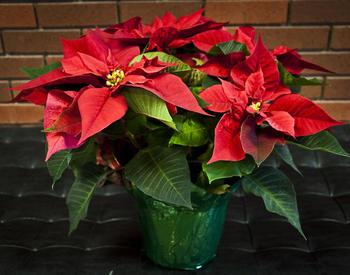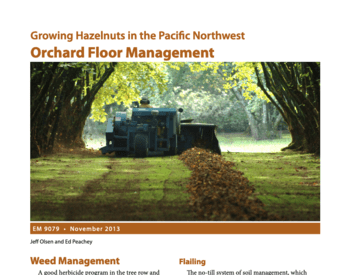When you garden along streams, remember that the groundwater table is shallow enough to interact with the roots of your plants; this is particularly true nearest the stream itself. Parts of your garden may also periodically flood. Native plants that grow naturally in or very near water (“at the water’s edge”) are adapted to conditions close to or actually in the stream. Other plants are suitable for drier areas above the actual water table.
Tips
- Native plants that do well near the stream often like to have "wet feet" at least during the rainy winter months. To help the young plants become established, remember to water them during the summer dry months for the first few years.
- If the area does not flood, two to four inches of mulch will help keep plant roots moist; any flooding will wash away mulch layers.
- Large trees provide shade to help keep the water cool, protecting fish and other wildlife. Shrubs provide additional wildlife habitat, shade and garden interest. The herb layer provides protective ground cover and seasonal interest.
- Ferns and fern-like plants look particularly “at home” in streamside gardens.
Trees for the water's edge
- White alder (Alnus rhombifolia): Forty to 50 feet; full sun; nitrogen fixer; tolerates poor, wet soil; was once the dominant alder in the Willamette Valley; butterfly host.
- Red alder (Alnus rubra): Forty feet or more; full sun; nitrogen fixer; tolerates poor, wet soil; more common in mountains but thrives in the Willamette Valley; butterfly host.
- Western red cedar (Thuja plicata): Tall (100 feet or more over time) graceful evergreen that prefers moist soil conditions; shade or part shade; butterfly host.
- Western crabapple (Malus fusca): Small deciduous tree to 40 feet; fragrant white/pink flowers in spring; yellow to reddish-purple fruit that may hang on over winter; full sun/part-shade; slow growing; may form thickets; butterfly host.
- Oregon ash (Fraxinus latifolia): Fifty feet or more; full sun/part-sun; tolerates seasonally wet areas or “wet feet”; compound and deciduous leaves; can be “messy” in a garden setting.
Trees for drier areas
- Oregon white oak (Quercus garryana): Deciduous tree to 100 feet or more; lobed dark green leaves; acorn fruit; full sun; well-drained soil; little or no summer water; butterfly host.
- Big-leaf maple (Acer macrophyllum): Deciduous tree to 50 feet or more; sun/part shade; large leaves; yellow fall color; butterfly host.
- Vine maple (Acer circinnatum): Small deciduous tree with graceful arching form (if grown in shade) to 15-30 feet; leaves bright yellow-green with yellow or red fall color; butterfly host.
- Bitter cherry (Prunus emarginata): Deciduous tree to 50 feet; reddish bark; fragrant clusters of white spring flowers; bright red fall fruits; yellow fall color; full sun/shade; butterfly host.
- Ponderosa pine (Pinus ponderosa, Willamette Valley form): Tall evergreen conifer to 100 feet or more; buff-colored bark; long needles in bundles of three; large cones; Willamette Valley form historically grew near streams; full sun to part sun; butterfly host.
- Cascara (Rhamnus purshiana): Small deciduous tree to 30 feet; silver bark; black berrylike fruit; butterfly host.
Shrubs for the water's edge
- Pacific willow (Salix lasiandra): One of many species found in the Willamette Valley; large shrub to 20 feet tall and wide; deciduous; host to many kinds of butterflies.
- Red twig dogwood (Cornus sericea): Deciduous multi-stemmed shrub to 16 feet tall; wide, reddish bark adds winter interest; flat-topped clusters of white flowers followed by white or bluish berries; sun/part-sun; butterfly host.
- Ninebark (Physocarpus capitatus): Multi-stemmed deciduous shrub to 8 feet or more; leaves resemble maple; clusters of white flowers in late spring; older stems have shredding bark; sun/part shade; butterfly host.
- Douglas spirea (Spiraea douglasii): Multi-stemmed deciduous shrub to 11 feet; gray-green leaves with pyramid-shaped clusters of pink flowers, turning brown after seed production; sun/part-shade; spreads underground to form colonies; butterfly host.
Shrubs for drier areas
- Tall Oregon grape (Berberis aquifolium): Broad-leaf evergreen shrub to 10 feet; spiny, glossy and compound leaves with bronze-copper new foliage; clusters of yellow urn-shaped flowers and blue fruit; sun preferred; butterfly host.
- Cascade Oregon grape (Berberis nervosa): Small, spreading, broad-leaf evergreen shrub to 2 feet; compound leaves and bright yellow flowers followed by blue fruit; can be slow to establish; spreads slowly; part to full shade; butterfly host.
- Red flowering currant (Ribes sanguineum): Deciduous shrub to 10 feet; upright stems growing from the base; gray-green leaves; pendant red flowers in clusters attractive to hummingbirds; black fruit is a bird favorite; sun/ part shade; butterfly host.
- Nootka rose (Rosa nutkana): Deciduous thorny shrub to 10 feet, some forms more spreading than tall; large solitary pink flowers up to 3 inches across; attractive hips; vigorous colonizer for sun/part shade; butterfly host.
- Snowberry (Symphoricarpos alba): Small spreading deciduous shrub to 3-4 feet with bluish-green foliage; small flowers; white berries persist through winter to provide winter food for birds; sun to shade but more berries in the sun; butterfly host.
- Red Elderberry (Sambucus racemosa): Large, deciduous multi-stemmed shrub to 20 feet tall and wide; bushier than blue elderberry; compound leaves; inflorescences of small flowers in a pyramid shape; bright red berries; butterfly host.
- Osoberry/Indian plum (Oemleria cerasiformis): Multi-stemmed shrub to 20 feet, pendulous cluster of white flowers in late winter followed by purple fruits in summer; can sucker from the base to form colonies; sun/part shade.
- Blue elderberry (Sambucus mexicana, also known as S. cerulea): Large multi-stemmed shrub or small tree to 15 feet or more; flat-topped clusters of white flowers followed by clusters of blue fruit; fast-growing; can form colonies; sun to part-shade; butterfly host.
- Mock orange (Philadelphus lewisii): Multi-stemmed deciduous shrub to 10 feet; masses of fragrant bright white flowers in late spring; sun/ part shade.
Flowering herbaceous plants for the water's edge
- Cattail (Typha latifolia): Widespread species growing in stagnant or slow-moving water; full sun; flowering stalks resemble a cat’s tail; forms dense colonies.
- Camas (Camassia leichtlinii): Spectacular bulb with spikes of blue flowers to 2 feet or more in May; requires winter wet and summer dry.
- Deschampsia (Deschampsia caespitosa): A native ornamental grass that grows in winter-wet but summer-damp or drier locations; most cultivars are of European origin so look for local species at native plant nurseries or sales.
- Yellow monkey flower (Mimulus guttatus): Bright yellow flowers in early summer/late spring on plants with pale green foliage to 3 feet; spreads vigorously; sun/part-sun.
- Skunk cabbage (Lysichiton americanus): Grows submerged in shallow water or very moist soil; yellow spadix on the inflorescence and large leaves provide striking garden accent; sun/part-shade.
- Wapato (Sagittaria latifolia): Grows in shallow water with muddy bottom; produces attractive, large arrow-shaped leaf; white flowers; will not survive around nutria because they eat the plants.
Flowering herbaceous plants for drier areas
- Goat’s beard (Aruncus dioicus): Herbaceous perennial to 6 feet; fern-like foliage and plumes of white flowers in early summer; resembles astilbe; requires some summer water; both male and female plants available.
- Goldenrod (Solidago sp.): Many native species available; herbaceous perennial 1-3 feet, depending on the species; bright orange-yellow flower in plumes in summer; reseeds freely and spreads underground; full sun; butterfly host.
- Douglas aster (Aster subspicatus): Spreading herbaceous perennial to 3 feet; blue/purple flowers mid to late summer; full sun; butterfly host.
- Blue-eyed grass (Sisyrinchium bellum): Herbaceous perennial to 16 inches; small blue flower with yellow eyes; grass-like leaves; sun/part shade.
- Columbine (Aquilegia formosa): Sturdy columbine to 3 feet with yellow and red flowers in May/June; full sun/part shade; butterfly host.
- Wild bleeding heart (Dicentra formosa): Delicate fern-like foliage to 12 inches or more; pink heart-shaped flowers; shade/part shade; will go dormant in the summer if not watered; butterfly host.
- Oregon iris (Iris tenax): Native iris with purple flowers to 14 inches; blooming in May; spreads slowly to form clumps; full sun/part shade; self-seeds.
- Yarrow (Achillea millefolium): Herbaceous perennial to 3 feet; fern-like foliage; white, flat-topped flowers nurture butterflies; full sun; spreads slowly to form patches.
- Stream violet (Viola glabella): Yellow flowers on plants to 5 inches; can spread slowly for groundcover if allowed; good as garden accent; shade/part-shade; butterfly host.
Ferns
- Lady fern (Athyrium filix-femina): Deciduous fern to 5 feet; prefers moist areas in part shade; finely divided, light-green foliage.
- Sword fern (Polystichum munitum): Statuesque evergreen fern to 5 feet; new foliage in March; sun to shade.
- Deer fern (Blechnum spicant): Dark green foliage; to 1.5 feet; separate stalks bear spores in summer; shade/part shade.
Groundcovers
- Bearberry or kinnikinnick (Arctostaphylos uva-ursi): Prostrate woody groundcover with trailing branches to 6 inches; leathery evergreen leaves; sun/part shade; well-drained soil; butterfly host.
- Wood sorrel (Oxalis oregana): Rapidly spreading groundcover to 8 inches; cloverlike leaves; white or pink flowers; prefers moist shade.
- Inside-out flower (Vancouveria hexandra): Deciduous groundcover to 2 feet; delicate foliage with bright yellow fall color; spreads underground; shade/part-shade; resembles epimedium.
- Wild strawberry (Fragaria virginiana): Spreading deciduous groundcover to 5 inches; bluish-green foliage; white flowers; red “tasty” fruit; sun/part-shade; butterfly host.
- Dunes strawberry (Fragaria chiloensis): Spreading evergreen groundcover to 9 inches; thick cloverlike leaves; white flowers; red fruit; sun to part-shade; butterfly host.



